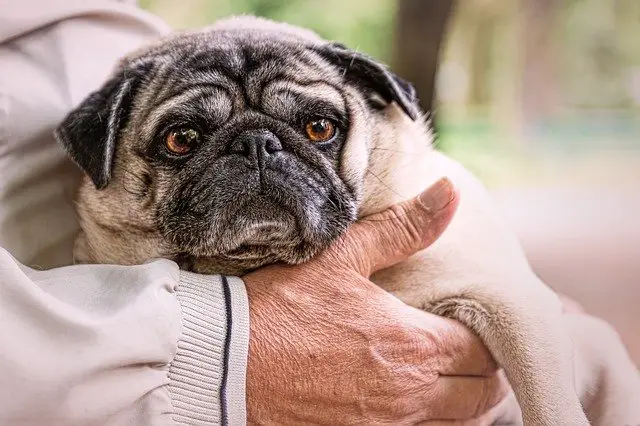Why is my dog’s head hot? The first thing any concerned pet parent would think of, when they find their dog’s head is hot or warm, is fever. However, in the majority of cases, a dog’s head being hot is usually nothing to worry about.
Continue reading if you want to know:
- 4 Tips to deal with a dog’s hot head or fever
- 9 Reasons why a dog’s head is hot.
- And more…
Why is My Dog’s Head Hot?
A dog’s head being hot isn’t always a cause for panic. However, it is important to know that a dog’s normal body temperature is between 101 and 102.5 F. In addition to fever, the reasons for a hot head in dogs include: natural cooling mechanism, stress, or vaccination.
9 Reasons Why My Dog’s Head is Hot?

#1. Fever
According to the Carolina Veterinary Specialists, dogs have a normal body temperature between 101 and 102.5 degrees Fahrenheit. For humans, the normal body temperature range is between 97 and 99 F. Therefore, to humans, a dog’s temperature will always be warmer or on the higher side.
The experts further state that dog’s body temperatures can change through the day and night too since many factors affect it (stress, activity, excitement, etc.). That is why, ascertaining whether a dog has a fever can be a bit tough.
Here are some ways to know if your dog has a fever:
- Normally, a dog’s nose is wet and cold to the touch. If it is dry, and your dog’s head and body feels warm, then it could have a fever.
- Since this isn’t an accurate indication of fever, it is best to use a rectal thermometer to know your dog’s exact temperature.
The video below shows you how to take your dog’s temperature using a rectal thermometer.
Never ignore a fever of more than 103.5 F in dogs. Take it to the vet right away. It is always better to be safe than sorry.
Causes of fever in dogs are:
- UTI
- Abscesses
- Infections – bacterial, fungal, or viral
- Infected scratch or bite.
If your dog is showing other signs of fever besides hot head, especially lethargy, cough, shivering, confusion, lack of appetite, etc. then please take it to the vet.
#2. Natural cooling mechanism
Dogs and heat do not go well together. In hot weather, dogs will pant to regulate their body temperature and cool down.
Since dogs do not sweat like humans, they use different cooling mechanisms to bring down their body temperature.
As part of the natural cooling mechanism, the dog’s body can transport more of the warmer blood towards the brain and head region. This can result in a warmer head than the rest of its body.
If you feel your dog is hot, move it to a cooler area, preferably with air conditioning. Make sure your pet drinks water. Continue monitoring its temperature and overall behavior. If s/he eats and drinks as usual, then there should be no cause for concern.
#3. Stress and excitement
A stressed or excited dog will pant and pace and that movement can easily cause its body temperature to increase. This can result in a hot head too.
According to Dr. Malcom Weir, DVM of VCA Hospitals, dogs can get stressed due to a variety of reasons. These include being left alone, the presence of another dog, change in routine, visitors, etc.. And when dogs do get stressed, they tend to pace, whine excessively, and especially change the position of their ears.
A stressed dog will pin its ears back against the head or raise them up to listen better. Since the ear bones are connected to the bones in the head and jaw, the constant movement could raise the head’s temperature. Also, as the dog perks its ears, yawns, or barks, its body -especially the head -generates a lot of warmth and appears warmer to the touch.
Dr. Weir suggests removing the stressors from the stressed dog’s environment. At the same time, it is important to avoid comforting it too much as that could positively reinforce the behavior. Instead, sit next to it and give it some routine commands to follow – sit, heel, etc. These can be very comforting to a stressed dog.
Dr. Weir also says that stress isn’t always a bad thing in dogs, just as in humans. A bit of stress can protect your dog from danger and keep it safe. Therefore, both dog owners and dogs should learn to deal with daily stresses.
#4. Vaccination side effect

If your dog has recently been vaccinated, there is a high chance that it could develop fever as a side effect of the same.
According to Dr. Jennifer Coates of PetMD, fever is the most common side effect of vaccinating a dog. Fever occurs because of the dog’s immune system reacting locally and systemically to the injection.
Dr. Coates further states that most dogs get back to normal within a day or two. If your dog continues feeling lethargic, or has prolonged soreness and hot head, then please call your vet.
Other side effects of vaccination are sluggishness, lumps and bumps, loss of appetite, swelling, diarrhea, and pain in the injection site. These usually go away within a day or so.
You should be on the lookout for anaphylactic shock – in very rare cases, a vaccination could cause seizures or difficulty breathing in pets. See your emergency veterinarian right away if these occur.
#5. Heat Stroke or hyperthermia
In rare cases, a heat stroke can cause a dog’s body and head to overheat.
In very hot weather, a dog left outdoors in the sun or in an overheated car could be at a risk of heat stroke – also called hyperthermia.
According to Carolina Veterinary Specialists, the symptoms of heat stroke are:
- Excess drooling
- Restlessness and panting
- Gums become red and swollen
- Vomiting
- Losing consciousness.
If you suspect that your pet is at a risk of a heat stroke, do the following:
- Cool your pet down gradually. You can place it in a bathtub and gently spray or pour water on it.
- Monitor its temperature using a rectal thermometer. Anything above 103 F – rush it to the vet.
- Give it some cool water or broth to sip or provide it with some ice cubes. Do not force it to drink too much water all at once.
- Watch out for symptoms like shock.
If the symptoms persist or worsen, please take it to the vet. Dogs that have had a heatstroke risk many complications including multiple organ failures. So, please treat this very seriously.
#6. Warmer ambient temperature
Sometimes, a dog having a hot head could have a simple explanation: it may be due to warmer-than-average ambient temperatures.
For example, your dog may have slept near the heating vent or under a blanket unbeknownst to you. This can also make its fur and coat warmer than usual.
Dogs are natural burrowers and diggers. They love digging holes in the sand and laying down in it. Indoors, they might dig and burrow in their dog beds or dog blankets to lay underneath them. This can easily cause their bodies to become warm, especially the head – if they have slept under the blanket for a prolonged period of time.
If your dog is behaving normally, eating well, and drinking plenty of water, then there is no cause for panic. The temperature should come down after a while.
#7. Allergies and excess chewing

When a dog furiously chews its paws or other parts on the skin, the chewing action can cause heat to build up in its head and cause a warming effect.
Afterall, canine jaw bones are connected to the skull and as a dog chews it can cause movement that generates heat and causes the head to overheat.
Mostly, dogs that chew their paws or other parts of the fur tend to have allergies – either food or environmental allergies. Allergies can also cause hot spots on certain parts of the skin. Resultantly, they tend to be warmer. A dog with food or environmental allergies often has a warm belly, paws, head, and ears.
Other signs of allergies in dogs are:
- Dull skin and coat
- Loose,watery stools
- Gas/flatulence
- Patchy hair loss/excess abnormal shedding
You must get rid of allergies by changing your dog’s diet and also reducing environmental allergens like dust and pollen. Speak to your vet regarding specific allergen that may be the source of trouble in your dog.
#8. Toxins
According to Vets–Now certain toxic foods or substances can also cause fever or a hot head and body in dogs.
Symptoms of poisoning tend to vary from dog to dog and mainly depend upon what your dog has swallowed.
Here is a list of common toxic foods and substances and the possible symptoms they can cause:
- Chocolate – The chemical in chocolate – theobromine – can cause convulsions, rapid heart beat, and agitation in dogs. Dogs that eat chocolate could also develop fever, vomiting, and tremors.
- Certain human drugs like ibuprofen – these can cause fever, sickness, vomiting, and – in large quantities – kidney failure.
- Rat toxin – common rat toxins are anticoagulants, bromethalin, and zinc phosphide. We have discussed these rat poisons and symptoms they could cause, in detail, in this guide.
- Onions – thiosulfate in onions and chives can cause fever, nausea, lethargy, sickness, drooling, and vomiting.
- Grapes and resins – vomiting and kidney failure
- Vitamin D – fever, diarrhea, vomiting, convulsions, and kidney failure.
- Antifreeze solution – this can cause symptoms like euphoria, delirium, lethargy, confusion, fever, vomiting, diarrhea, etc.
- Toxic plants – many plants like sago plant, tomato, poison ivy, amaryllis, daffodil, aloe vera, and gladiola are toxic to dogs. They can cause symptoms like sickness, diarrhea, vomiting, muscle weakness, or unconsciousness in dogs.
If you suspect your dog has been poisoned, then please see your nearest vet. The vet will want to know the following details:
- Your dog’s age and weight
- The toxic substance it ingested and how long ago.
Your vet might induce vomiting to remove the offending substance. Never try to induce vomiting at home.
Also Read: 30 Toxic Foods for Dogs
#9. Certain diseases or infections
When a dog has an infection or inflammation, then too it could develop a hot head or a warm body. Several infections like ear infections, oral infections, dental abscesses, and bacterial and viral diseases can lead to fever and related symptoms in dogs.
Many canine cancers can also lead to fever in dogs: lymphoma, leukemia, multiple myeloma, hepatic neoplasia, and necrotic tumor masses.
Other causes of persistent fever or hot head in dogs are:
- Tick borne diseases
- Granuloma
- Leukemia
- Lymphoma
- Pancreatitis
- Intervertebral disc disease
If your dog has consistently been having a hot head and body along with other signs, your vet might recommend several tests to diagnose the exact cause. Treatment may then include a combination of antibiotics, antipyretics, NSAIDs, steroids, and, in case of cancer- chemotherapy or surgery.
4 Tips to Treat Hot Head and Fever in Dogs

#1. Wait and watch approach
Most cases of hot head and fever in dogs should resolve on their own. Dogs use their own natural cooling mechanism and this can bring down the body temperature.
If fever persists, other symptoms manifest, or the rectal thermometer shows a reading over 103 F, please see your vet right away.
#2. Use cool water
The AKC recommends applying cool water around the dog’s paws and ears (if your pet allows it) to bring down its temperature. You can also use an ice bag or frozen vegetable packets to reduce the dog’s temperature. Alternatively, place the dog in a bathtub and gently wet its limbs. If your dog is shivering, do not use this method.
#3. Coax it to drink water
Provide some electrolyte solution or cool water for your dog to drink. Do not force it lest it vomits. You can also offer some broth or a bland stew to keep your pet hydrated.
#4. Continue monitoring the temperature
Even if you manage to bring down your dog’s temperature using cool water, monitor it regularly. If he/she shows any other signs or the fever continues, then please see your vet. Remember: it is better to be safe than sorry.


